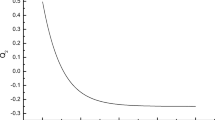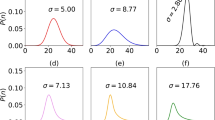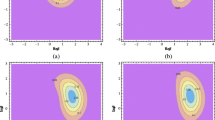Abstract
We introduce the superposition of photon subtraction and photon addition excited squeezed thermal state (SPSAST) that is generated by operation of superposition of photon subtraction and photon addition on squeezed thermal state. By the technique of integration within an ordered product of operators, we derive its normalization constant and the analytical expression of its Wigner function. The influences of the squeezing parameter and superposition coefficient of operators on its non-classical properties are discussed. Numerical results show that its non-classical properties are firstly strengthened with the increasing of the squeezing parameter in the beginning. However, when the squeezing parameter is larger than a certain value, its non-classical properties are weakened as the squeezing parameter continues to grow. The influence of the superposition coefficient of operators on its non-classical properties is complex. On the other hand, its non-classical properties are weakened with the increasing of the average photon number in the thermal state.
Similar content being viewed by others
Avoid common mistakes on your manuscript.
1 Introduction
The preparation and construction of non-classical states, and the study of their quantum properties, have been a perennial topic in quantum optics and quantum information science. There are many methods of quantum state construction. Using state superposition principle of quantum mechanics and operators acting on the light field state are two main kinds of methods to construct a new quantum state. So far, some proposals have been put forward to construct a new quantum state by using state superposition principle of quantum mechanics [1,2,3,4]. For example, Janszky et al examined the problem of quantum-mechanical interference of multiple Schroödinger-cat states consisting of coherent states on the same circle [1], Schleich et al constructed the quantum-mechanical superposition of two coherent states of identical mean photon number, and so on [3, 4]. In 1991, Agarwal et al firstly introduced excited coherent state which is constructed by photon addition operator a + acting on coherent state [5]. Photon subtraction and addition represented by bosonic annihilation operator a and creation operator a + are proved to be employed to transform a field state to a desired one. In recent years, a lot of proposals have been put forward to generate highly non-classical quantum states by operator acting on light field state [6,7,8,9,10,11,12,13,14]. For example, Xu et al investigated the non-classical properties of arbitrary number photon annihilation-then-creation operation and creation-then-annihilation operation to the thermal state [6]. Zhou et al constructed the photon-subtracted two mode squeezed thermal state [7]. In Ref. [8], a class of the generalized photon-added coherent states was proposed, and its quantum statistical properties were studied. In the aspect of experiment, the Zavatta’s group prepared the single photon-added coherent state by using parametric down-conversion [15]. Currently, photon-added squeezed thermal states and photon-subtraction squeezed thermal states have been studied [16, 17]. However, the construction of superposition of photon subtraction and photon addition excited squeezed thermal state and the investigation of its quantum properties have not been reported. In the present paper, we shall introduce SPSAST, and calculate its Wigner function. Furthermore, we will discuss the influences of the squeezing parameter and superposition coefficient of operators on its non-classical properties.
The rest of the paper is structured as follows. In Section 2, we derive the normal order of the density operator of squeezed thermal state. In Section 3, we introduce SPSAST. In Section 4, we calculate its Wigner function with different squeezing parameter and superposition coefficient. In Section 5, the negative volume of Wigner function is studied. The main results are summarized in Section 6.
2 The Normal Order of the Density Operator of Squeezed Thermal State
The density operator of thermal state with frequency ω in a thermal equilibrium state corresponding to absolute temperature T is
where \(\beta =\frac {\hslash \omega } {k_{B} T}\), k B being Boltzmann’s constant. Its average photon number is
The Weyl-ordering form of ρ t can be written as [18]
where the symbol \({\begin {array}{*{20}c} : \hfill \\ : \hfill \\ \end {array}} {\begin {array}{*{20}c} : \hfill \\ : \hfill \\ \end {array}} \) denotes Weyl-ordering.
On the other hand, the single mode squeezing operator and its transformation can be written as
where λ being squeezing parameter. For the sake of simplicity, we set that λ is real. Using the operator’s Weyl-ordering invariance under similarity transformation O,
which means that O can penetrate through the “fence” \({\begin {array}{*{20}c} : \hfill \\ : \hfill \\ \end {array}} {\begin {array}{*{20}c} : \hfill \\ : \hfill \\ \end {array}} \), then Combining (3) and (4), we get the density operator of squeezing thermal state
According to the Weyl rule, the classical correspondence of a Weyl ordered operator can be obtained by replacing a and a + by α and α ∗, respectively, thus the classical correspondence of squeezing thermal state is
According to the definition of Weyl correspondence rule which connects a classical function h(α, α ∗) and its operator correspondence F(a, a +)
where \({\Delta } (\alpha ,\alpha ^{\ast } )=\frac {1}{\pi } :\exp [-2(a^{+}-\alpha ^{\ast } )(a-\alpha )]:\) denotes the Wigner operator, :: denotes the normally ordering. Substituting (7) into (8), we finally obtain the normally ordering form of ρ st
where
3 Introduction of SPSAST
SPSAST can be constructed through coherent superposition of photon subtraction and addition ra + qa + acting on squeezing thermal state. Its density operator is expressed as
where N being normalization constant, r and q are superposition coefficients with |r|2 +|q|2 = 1. For the sake of simplicity, we set that r and q are real. Using the completeness relation of coherent state \(\int {\frac {d^{2}z}{\pi } } \left | z\right \rangle \left \langle z \right |=1\), N can be determined by trρ = 1.
where tr denotes tracing. Substituting (11) into (12), after lengthy calculations we get
In the derivation of (13), we have used the following operator formulas
the integration formula
whose convergent condition is Re(λ ± f ± g) < 0 and Re[(λ2 − 4fg)/(λ ± f ± g)] < 0, and the formula
4 Wigner Function
Since Wigner first instructed Wigner function [19], Wigner function has become a very popular tool to study the non-classical properties of quantum states. Its negativity implies the highly non-classical properties of quantum states. For a state with density operator ρ, its Wigner function in the coherent state representation |z〉 can be expressed as
Substituting (11) into (17), after straightforward calculation, we obtain the Wigner function of SPSAST
Because \(\alpha =\frac {(x+ip)}{\sqrt 2} \), the Wigner function is transformed into a function of variable of coordinate x and momentum p
4.1 The Influences of the Squeezing Parameter λ on the Wigner Function
In order to discuss the influences of the squeezing parameter λ on the Wigner function, it sets the average photon number in the thermal state \(\bar {{n}}\) equals 0.1, and the superposition coefficient of operators r equals 0.1. We draw three-dimensional graphs of W(x, p) using (19) for a different value of the squeezing parameter λ in Fig. 1. Comparing the graphs of W(x, p) with different λ, we find: when λ is larger than a certain value, W(x, p) displays negative value; then the negative region and the negative depth of W(x, p) are strengthened with increasing of the squeezing parameter λ. For example, when λ equals 0.4, the Wigner function does not display negative value; when λ equals 0.6, the negative depth of W(x, p) equals −0.01904; when λ equals 0.8, the negative depth of W(x, p) equals −0.02609; but when λ continues to grow, the negative depth of W(x, p) is weakened. For example, when λ equals 1.0, the negative depth of W(x, p) equals − 0.02245; when λ equals 1.4, the negative depth of W(x, p) equals − 0.00904; when λ equals 1.8, the negative depth of W(x, p) equals − 0.00247. These results show that its non-classical properties are firstly strengthened with the increasing of the squeezing parameter, then are weakened when the squeezing parameter is larger than a certain value.
4.2 The Influences of the Superposition Coefficient of Operators r on the Wigner Function
When it sets the average photon number in the thermal state \(\bar {{n}}\) equals 0.1, and the squeezing parameter λ equals 1.0, the three-dimensional graphs of W(x, p) for some given superposition coefficients r are plotted in Fig. 2. From Fig. 2 we find: the influence of the superposition coefficient of operators r on its non-classical properties is complex. The numerical results show that the negative region and the negative depth of W(x, p) are sometimes strengthened and are sometimes weakened. For example, when r equals 0, the negative depth of W(x, p) equals −0.0259; when r equals 0.2, the negative depth of W(x, p) equals −0.01845; when r equals 0.4, the negative depth of W(x, p) equals −0.00779; when r equals 0.6, the Wigner function does not display negative value; when r equals 0.7, the negative depth of W(x, p) equals −0.03791; when r equals 0.8, the negative depth of W(x, p) equals −0.64622; when r equals 0.9, the negative depth of W(x, p) equals −0.20332; when r equals 1.0, the negative depth of W(x, p) equals −0.0813.

5 The Volume of the Negative Part of the Wigner Function
The volume of the negative part of the Wigner function is a signature of non-classical properties of quantum state. It is defined as
The larger the negative volume of Wigner function is, the stronger the quantum properties of the state is. Firstly, we discussed the evolution of the negative volume of Wigner function with r. Set the average photon number in the thermal state \(\bar {{n}}\) equals 0.1, the squeezing parameter λ equals 1.0, The evolution of V (t) with r is plotted in Fig. 3. The curve in Fig. 3 shows that as r increases, the negative volume of Wigner function appears firstly to decrease slowly, then increases. After it reaches its maximum, it decreases again.
Secondly, the influence of the squeezing parameter on the negative volume of Wigner function is discussed. When it sets the average photon number in the thermal state \(\bar {{n}}\) equals 0.1, and the superposition coefficient of operators r equals 0.1. The evolution of V (t) with squeezing parameter λ is plotted in Fig. 4. From Fig. 4, the negative volume of Wigner function appears firstly to increase, then decreases. When λ equals 0.85 the peak of the curve appears. The result is consistent with the result in Fig. 1. This shows that choosing the appropriate squeezing parameter is advantageous for non-classicality of SPSAST.
Thirdly, we investigate the effect of the average photon number in the thermal state \(\bar {{n}}\) on the negative volume of Wigner function. When it sets the squeezing parameter λ equals 1.0 and the superposition coefficient of operators r equals 0.1, we plot the evolution curve of V (t) with the average photon number in the thermal state \(\bar {{n}}\) in Fig. 5. It shows that the negative volume of Wigner function decreases as \(\bar {{n}}\) increases. This is because the greater the average number of photon is, the higher the temperature is, the stronger the non-classicality of the thermal state is.
6 Conclusions
In this paper, we construct SPSAST by operation of superposition of photon subtraction and photon addition on squeezed thermal state. The normalization constant of SPSAST is derived by the technique of integration within an ordered product of operators. Furthermore, we derive the expression of its Wigner function. The influences of the squeezing parameter and superposition coefficient of operators on the negative of Wigner function are analyzed. Numerical results indicate : firstly, the negative region and the negative depth of Wigner function of SPSAST are firstly strengthened with the increasing of the squeezing parameter in the beginning, and then are weakened when the squeezing parameter is larger than a certain value; secondly, the negative region and the negative depth of Wigner function of SPSAST are sometimes strengthened and sometimes weakened as the superposition coefficient of operators r increases; thirdly, the negative volume of Wigner function decreases as the average photon number in the thermal state increases.
References
Janszky, J., Domokos, P., Adam, P.: Phys. Rev. A 48, 2213 (1993)
Schleich, W., Pernigo, M., Kien, F.L.: Phys. Rev. A 44, 2172 (1991)
Liang, M.L., Yuan, B.: High Energy Phys. Nucl. Phys. (Chinese) 26, 900 (2002)
Lu, D.M.: Chin. Phys. B 17, 618 (2008)
Agarwal, G.S., Tara, K.: Phys. Rev. A 43, 492 (1991)
Xu, X.X., Yuan, H.C., Wang, Y.: Chin. Phys. B 23, 070301 (2014)
Zhou, J., Fan, H.Y., Song, J.: Int. J. Theor. Phys. 51, 591 (2012)
Yuan, H.C., Xu, X.X., Fan, H.Y.: Chin. Phys. B 19, 104205 (2010)
Lee, S.Y., Nha, H.: Phys. Rev. A 82, 053812 (2010)
Lee, S.Y., Ji, S.W., Kim, H.J., et al.: Phys. Rev. A 84, 012302 (2011)
Hu, L.Y., Xu, X.X., Wang, Z.S., et al.: Phys. Rev. A 82, 043828 (2010)
Zhou, J., Song, J., Yuan, H., et al.: Chin. Phys. Lett. 29, 050301 (2012)
Lu, D.M.: Chin. Phys. B 23, 020302 (2014)
Wang, S., Hou, L.L., Xu, X.F.: Opt. Commun. 335, 108 (2015)
Zavatta, A., Parigi, V., Kim, M.S.: Phys. Rev. Lett. 103, 140406 (2009)
Xu, X.X., Hu, L.Y., Fan, H.Y.: Opt. Commun. 283, 1801 (2010)
Zhang, H.L., Jia, F., Xu, X.X., et al.: Int. J. Theor. Phys. 51, 3330 (2012)
Fan, H.Y.: Ann. Phys. 320, 480 (2006)
Wigner, E.: Phys. Rev. 40, 749 (1932)
Acknowledgements
This work is supported by the Natural Science Foundation of Fujian Provice of China Under Grant No.2015J01020.
Author information
Authors and Affiliations
Corresponding author
Rights and permissions
About this article
Cite this article
Lu, DM. Superposition of Photon Subtraction and Photon Addition Excited Squeezed Thermal State and its Wigner Function. Int J Theor Phys 56, 3514–3524 (2017). https://doi.org/10.1007/s10773-017-3516-2
Received:
Accepted:
Published:
Issue Date:
DOI: https://doi.org/10.1007/s10773-017-3516-2









